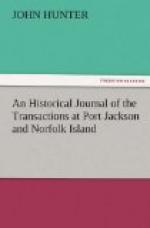The entrance of the harbour of Port Jackson has nothing in its appearance, when six leagues from the land, by which it may be known; your latitude will be your most infallible guide to this harbour, or indeed to any other upon this coast. Steer in for the land, which here lies about north by east half east and south by west half west; keep as near as you can in latitude 33 deg. 50’ south; the entrance, when you come near, will show itself, by the heads on each side, which are high, steep, perpendicular cliffs, of a light reddish colour; a ship bound in here, may run in without fear between the heads, which are distant from each other one mile and three quarters; there is nothing in the way, and the shore pretty steep to on each side; the sea breaking, which it does even in fine weather, will show any rocks which may lie near under the shore. Steer in between the heads for a high bluff point, which is called Middle Cape or Head, and is steep to, until you open to the southward of you a very extensive arm of the harbour.
If the wind be sufficiently large to run up this branch, (which lies by compass south-west by south) on either shore, haul round the east-most point of this arm, which is called the Inner or South Head; it is a low rocky point; give it a birth of two-thirds of a cable, and steer right in for the first sandy cove above it, on the same side, called Camp Cove; keep at a convenient, but small distance from the shore, in three and a half and four fathoms, and observe, that right off this cove, and near mid-channel, lies a patch of rocks, which appear at half-tide; the shoaling toward them is gradual all round, upon a smooth sandy bottom; it is rocky only about half a cable’s length from the dry part; you may keep near the upper point of Camp Cove, in six and seven fathoms, and from thence steer directly up the harbour. If you intend to go on the west shore, and to leave this patch of rocks to the eastward of you, steer in as before for Middle Head, and when within a cable’s length of it, steer up for the next point above it, on the same side, observing not to make too free with that point, as it is rocky something more than half a cable’s length off. In this channel, which is much the best, being rather broader than the eastern channel, you will have four, four and a half, and five fathoms. When you are above this second point, on the west shore, you may take what part of the channel you please, or anchor wherever you wish, there being nothing in the way from shore to shore.
The chart will certainly be the best guide in going in. If the wind should be southerly, a stranger would not venture to work up, but he might anchor with safety in the north part of the harbour, which he will perceive by the chart, to which I would refer him, rather than to a written description*.
[* For an accurate survey of this harbour, see a Chart of Port Jackson, by Captain Hunter, in Phillip’s Voyage, 4to. Edition.]




